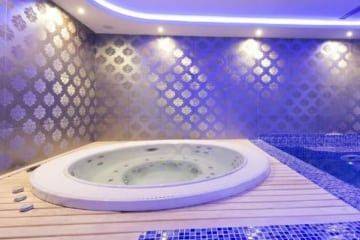
Six sauna and hammam questions to read before you start.
These are some of the most popular questions to help you decide which of the wellness facilities (sauna, hammam, hot tub) is best for you:
- Do the sauna and hammam have the same effect?
A sauna is a very hot environment, wet or dry. A wet sauna or hammam consists of a steam bath, while a dry sauna uses stones or other material, which is heated without giving off steam. The temperatures are also different: the wet sauna rarely exceeds 60 °C, while in the dry sauna the body can easily tolerate temperatures above 80 °C for a short time. A sauna is therefore characterized by dry heat, 80 °C to 100 °C and very low relative humidity (less than 15%).
Some people find that the dry heat of the sauna can make breathing difficult. People with respiratory problems such as sinusitis and asthma usually prefer the moist heat of the hammam. Steam inhalation is often used to treat bronchitis, sinusitis and allergies. Therefore, people with these problems can benefit from a steam bath. - The hot tub is recommended hot water if I suffer from traffic problems?

Hot water bubbles on the skin stimulate blood circulation throughout the body as they dilate blood vessels and increase body temperature. This is particularly beneficial for heart health and therefore improves circulation. The jacuzzi or hot tub has a number of health benefits:
• Relaxes the muscles
• Reduces fatigue and stress
• Lowers blood pressure
• Recommended for the treatment of insomnia
• Helps recovery after sports training
• Improves recovery from fractures or muscle injuries
• Relieves bone pain and arthritis - How long and how often can I use wellness facilities such as the sauna?
Using various wellness facilities is a healthy activity in almost every way, although you should control times and temperatures, especially if you have low blood pressure. Therefore, we suggest you visit them 3 times a week, 20 to 30 minutes to rejuvenate. - Is it necessary to drink fluids while in the sauna?
After a sauna session you will be quite dehydrated, having lost up to 2 liters of water, as well as many minerals. It is therefore recommended to drink fluids during or after a sauna session: if possible have an isotonic drink to recover minerals.

- Can a pregnant woman use these facilities?
Studies conducted in the US show that pregnant women should not use wellness facilities such as saunas and hot tubs, as excessive heat is not beneficial for the baby's development. Those planning pregnancy should limit the use of both. - Are the sauna & hammam facilities dangerous for people with heart problems?
Because of the extreme heat, especially in saunas, pregnant women, people with heart problems, high or very low blood pressure (or those taking any medicine that affects blood pressure), epileptics, people taking antibiotics or any type of medicine that affects mind (such as stimulants, sedatives, alcohol) should not use the sauna or steam room. As always, please consult your doctor to make sure you can use the sauna or hammam safely.

Despite having very similar goals, there are differences between a sauna and a steam room. While the heat in the sauna is dry and high, the hammam has a lower temperature and more humidity. The body's reaction is the same in both cases: when the outside temperature is higher than the body's, it sweats to cool itself by secreting fluid from the dilated pores. This sweat absorbs heat during evaporation. In a hammam, however, you don't sweat because the steam absorbs the heat. Choosing one of the specific facilities will ensure you more well-being. Try the most suitable one for you, as an alternative proposal during the time you spend inside the Club.
The group of Holmes Place

No Comments